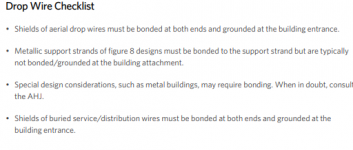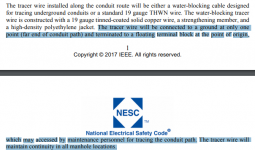jstpie5
Member
- Location
- Baton Rouge
Is there any NEC / NESC or other requirement to ground/bond the tracer wire on communication wire on one end (Fiber in this case)?
Here's the scenario:
There is a 138kV transmission line near a large solar farm and a 7.62kV distribution line running parallel about 50ft away serving residential power. Direct bury fiber was installed (above ground) on the distribution line poles but the tracer was not grounded at either end.
The tracer wire has ~850Vac when measured to a good ground due to what I think is induced voltage from the 138kV transmission line. The communication company says it's the utilities (distribution line) company's fault and vise versa.
The fiber company says they don't need to ground the tracer because it's not designed to carry current. They said they are going to remove it from the pole and bury it. I'm afraid there will still be induced voltage on the fiber after they bury it (probably only going to bury 10" or so).
Please tell me there is a requirement to ground/bond the tracer...
I found this article from Corning (https://www.corning.com/catalog/coc/documents/standard-recommended-procedures/005-012.pdf) - see section 2.27
I was thinking maybe NESC rule 99 would be applicable but not totally sure.
Here's the scenario:
There is a 138kV transmission line near a large solar farm and a 7.62kV distribution line running parallel about 50ft away serving residential power. Direct bury fiber was installed (above ground) on the distribution line poles but the tracer was not grounded at either end.
The tracer wire has ~850Vac when measured to a good ground due to what I think is induced voltage from the 138kV transmission line. The communication company says it's the utilities (distribution line) company's fault and vise versa.
The fiber company says they don't need to ground the tracer because it's not designed to carry current. They said they are going to remove it from the pole and bury it. I'm afraid there will still be induced voltage on the fiber after they bury it (probably only going to bury 10" or so).
Please tell me there is a requirement to ground/bond the tracer...
I found this article from Corning (https://www.corning.com/catalog/coc/documents/standard-recommended-procedures/005-012.pdf) - see section 2.27
I was thinking maybe NESC rule 99 would be applicable but not totally sure.



